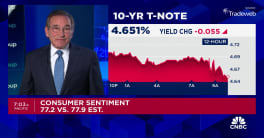The 4.7% decline in U.S. pending home sales in May shows that the previous month's gain was not a true sign of stabilization, economists said after a release the National Association of Realtors on Tuesday.
Patrick Newport, U.S. economist at Global Insight, called the report "disappointing," noting that a lot of forces such as tight credit and rising interest rates in May were at work to bring down each of the four regions' sales. He said previous data suggested signs of stabilization, but this release indicates the housing market has yet to hit a bottom.
Sales in the Midwest fell 6.0%, the South fell 7.1%, the West dropped back 1.3%, and the Northeast fell by 2.9% from the previous month. Meanwhile, the nationwide gain in April was revised up to 7.1% from 6.3% -- the gain followed declines in five of the previous six months.
Newport forecasts an additional 10% decline before a bottom is reached, which he doesn't expect to see until early next year.
The consensus was expecting the PHSI to fall by 3.0% in the month, with estimates ranging from -6.0% to +0.2%. The PHSI now stands at 84.7, down from 88.9 in the previous month (revised from 88.2). From a year prior, the index has declined by 14.6%.
Charmaine Buskas, senior economics strategist at TD Securities, said "the pace of sales remains very weak," though she noted that 14.6% annual decrease is a slower pace of decline that the 20% year-over-year decrease reported in March, when the index hit an all-time low at 83.0.
Ian Shepherdson, chief U.S. economist at HFE, said "the overall picture of the index over the past few months is one of broad stability," yet he called the housing sector "desperately weak" and commented it is "still much too early" to call for a bottom.
"(T)here was a bigger, longer improvement in the winter of 2006/7 which eventually was followed by a renewed collapse," he added.
The NAR projects the aggregate median existing-home price to fall 6.2% this year to $205,300, and then rise by 4.3% in 2009 to $214,100.
"We are not out of the woods by any means," said Lawrence Yun, chief economist at the NAR.
The PHSI looks at home sales that have been signed but not finalized, a process that takes another month or two. The value of the index lies in its ability to forecast existing home sales, which represent eight-tenths of the market.
NAR President Richard F. Gaylord said the current market offers immediate benefits and long-term value for many buyers, adding that homebuyers can get a great deal right now.
"Although inflationary expectations appear to be under control for the time being, sharper consumer price gains could lead to notably higher mortgage interest rates in 2009," he said.
Yun said, "The speed at which home prices has declined in a few select markets is unprecedented, but the large price declines in those areas have enticed bargain hunters back into the market. Interestingly, there have been reports of multiple bidding after the large price cuts, so it is possible that most of the price declines have already occurred in those markets."
The next existing home sales report, which looks at sales for June, comes out on July 24.
By Patrick McGee and edited by Cristina Markham







